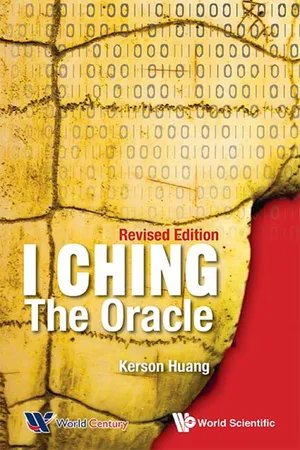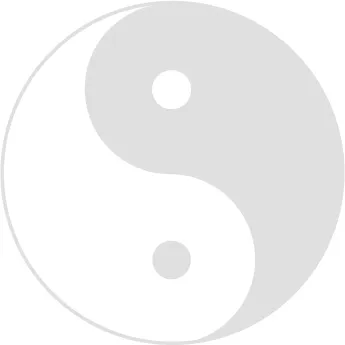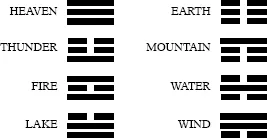![]()
Part I
ABOUT THE I CHING
![]()
1 INTRODUCTION
The Binary Nature of Things
You might have heard about the I Ching, or even used it. Its underlying idea is that two basic attributes lie at the root of all things, called Yin and Yang. Yin is passive, yielding, and nurturing, while Yang is active, dominating, and creative. Symbolically one draws a broken line to represent Yin, and a solid line to represent Yang:
Far from being static, these attributes change into each other continually. When Yin holds sway for too long, it “grows old”, and renews itself by changing into Yang, and vice versa. The alternation between Yin and Yang was held to be the moving force of our world and all its manifestations, whether social, political, economic, or psychological.
How could complex situations be symbolized in terms of just the two elements Yin and Yang, you might ask. The answer is that any concept, however intricate, can be described by a string of Yin’s and Yang. At any particular moment, a situation may have an admixture of Yin and Yang in varying proportions, and each elementary component may have varying tendencies towards changing. That’s how the world can move in an unending variety of ways.
The idea that you can describe anything in terms of only two basic elements is the essence of binary mathematics, the language of the modern computer. In mathematical terms, any integer can be represented by a sequence of 0’s and 1’s. And you can convey any idea in terms of the integers. As a modest example, this book is written on a word processor, which internally records each character as an integer, in a form readable by a computer.
As Gauss (1777-1855), one of the greatest mathematicians of all times, said, “God created the integers; everything else is man-made.”
The Eight Elements
How does the I Ching integrate the idea of Yin and Yang with that of change? The scheme was developed in stages. The early Chinese thought that the world can be broken down to eight basic elements. They symbolized them by putting together three binary elements, resulting in the eight trigrams:
The trigrams make intriguing motifs. For example, four of them adorn the Korean national flag. They are sometimes displayed in the octagonal arrangement shown in Fig. 1. In the center is the “Taiji” (Primordial Polarity), a circle divided into intertwining black and white areas. The white represents Yang, and the black represents Yin. The two little dots remind us that Yin and Yang constantly change into each other.
The Sixty-Four Hexagrams
After the trigrams were cooked up, someone had the bright idea of stacking a trigram on a trigram, making a hexagram. Sixty-four in all, the hexagrams were used to express complex ideas built from the rudimentary trigrams. An index of hexagrams may be found in Appendix A. We give some examples here:
The original I Ching is none other than the sixty-four hexagrams, with a text associated with each hexagram, for use in divination. The text sometimes tells a story, sometimes gives an omen; but it always says things in human rather than supernatural terms.
When one consults the I Ching as oracle, one chooses the hexagram that provides answers to a question according to some methods, which we shall explain later. In the court of the Zhou Dynasty of 1100 BC this was an important ritual, officiated by the court historian. He would read and interpret the hexagram texts, and advise the King on the question raised, such as whether or not to go to war. We shall show examples from historical records later.
The I Ching as we know it today is one of the five core Confucian classics, the “bible” of Confucianism, which has been adopted as state teaching since the Han dynasty around 200 BC. Beside the original text, it includes the Ten Wings, essays that expound the philosophy of Yin and Yang in terms of Confucian morality. In this book, we confine ourselves to the original text, and let the modern reader encounter it, each in their own way.
Fig. 1 Trigrams surrounding the Taiji.
The Idea of Change
Here’s how Yin and Yang get integrated with the idea of change, through the sixty-four hexagrams. If Yin could change into Yang and vice versa, then any line in a hexagram can change. In so doing, it changes the original hexagram into a new one. Thus each line has its own dynamics, through which the static hexagrams acquire motion.
One might associate a particular moment in a human situation with some hexagram whose lines have varying “ages”. The young one will not change, while the old ones will change to its opposite. The hexagram it would change to, and the lines responsible for the change, would provide a reading of the portents.
For a reading, then, one would choose six lines at random. Each of the lines has four possible values, corresponding to Yin or Yang, and changing or unchanging. The six lines so chosen would yield an original hexagram signifying an initial situation, and a changed hexagram corresponding to the eventual development.
With six lines to a hexagram, and four possible values to each line, the number of combinations available to describe different situations comes out to be 4096, or 4K in computerese. The dynamics of change has expanded the sixty-four static hexagrams into more than four thousand patterns of development.
Thus, when you consult the I Ching, you can get 4K different readouts. Of course, no two persons would interpret a message the same way, nor would the same person interpret a message the same way on different occasions. Hence the real possibilities are limited only by your imagination.
A common method of choosing a line is to toss three coins. There are exactly four possible outcomes, giving you four possible kinds of lines. So, one toss gives you a line, and six tosses get you a hexagram. You draw the original and the changed hexagrams, and open up the I Ching to the right place to read the message. We will tell you how to do this later.
About This Book
Part I of this book contains the story of the I Ching, which is inseparable from the story of China. The story of how the original meaning is recovered from archeology and modern textual studies is told in a popular account, with no claim to scholarship. There is a chapter discussing various issues related to the I Ching, and finally there is a how-to chapter on using the I Ching.
Part II contains the new translation of the original I Ching, without the obligato of Confucian comments. The original Chinese text is set side-by-side, and emendations made are noted.
The hexagrams are arranged in what is known as the “King Wen order”, and numbered 1 to 64. There is an alternative arrangement known as the “Fuxi order”. We adopt the King Wen order, and referred to a hexagram by number followed by name in block letters, e.g. 18 WORK.
You might find several appendices helpful. Appendix A contains a list of the hexagrams, with a look-up table that gives the hexagram numbers corresponding to given upper and lower trigrams. A guide to the Chinese Pinyin system of pronunciation is provided in Appendix B.
![]()
2 LEGEND OF THE I CHING
In the Beginning
In the beginning there was nothing. The vapors that were light gathered together, and so did the vapors that were heavy. The former is called Yang, symbolized by a solid line
; the latter is called Yin, symbolized by a dashed line
.
And thus there were two.
An early sage (some say emperor) Fuxi, whose identity and times were lost in deep antiquity, conceived the trigrams, which consist of groups of three lines stacked one above the other. There are eight trigrams, and they symbolize the basic elements of a recognizable universe.
And thus there were eight.
Millennia passed. Legendary dynasties rose and fell. Some time around 2000 BC came the Great Deluge, a great flood covering the earth. A...







